John Krafcik, the former CEO of Waymo who led the company’s transition from a research project to a commercial robotaxi service, has expressed his disdain for Elon Musk’s Tesla Robotaxi hype. When asked about Waymo’s rival, Krafcik said, “Please let me know when Tesla launches a robotaxi — I’m still waiting.”
In a recent exchange with Business Insider, John Krafcik, the former CEO of Google’s Waymo, shared his skepticism regarding Tesla’s Robotaxi service, which launched in the San Francisco Bay Area in July as a chauffeur service featuring human drivers. Krafcik, who led Waymo from 2015 to 2021 and now sits on the board of Tesla rival Rivian, questioned whether Tesla’s offering can truly be considered a robotaxi service.
“Please let me know when Tesla launches a robotaxi — I’m still waiting,” Krafcik told Business Insider. “It’s (rather obviously) not a robotaxi if there’s an employee inside the car.”
Tesla’s Robotaxi service, which remains invite-only, currently requires a human safety monitor to sit behind the steering wheel, as the company has yet to apply for permits that would allow it to test and deploy fully driverless taxis in California. In Austin, where regulations around autonomous vehicle deployment are less stringent, the safety monitor sits in the front passenger seat of the Model Y.
Krafcik’s comments highlight the ongoing debate within the industry about what constitutes a true robotaxi service. The Society of Automotive Engineers (SAE) defines six levels of autonomous driving, with Level 4 and Level 5 describing autonomous systems that do not require human intervention when requested. It remains unclear whether Tesla’s Robotaxi service in the Bay Area would be considered Level 3, which requires a driver to take over the vehicle only when the autonomous system requests an intervention.
In contrast to Tesla’s approach, Waymo began offering fully driverless paid rides in Phoenix in late 2020 and has since expanded the service to several U.S. cities, including San Francisco, Los Angeles, and Austin, with more than 1,500 robotaxis on the road. However, Waymo’s initial rollout in 2017 shared some similarities with Tesla’s current Robotaxi launch, including the presence of safety drivers and a select group of riders bound by non-disclosure agreements.
Krafcik emphasized that during this stage, Waymo did not refer to its service as a “robotaxi.” He stated, “I think the AV industry would be delighted if Tesla followed Waymo’s approach to launch a robotaxi service, but they are not doing that.”
Read more at Business Insider here.
Lucas Nolan is a reporter for Breitbart News covering issues of free speech and online censorship.
Read the full article here


